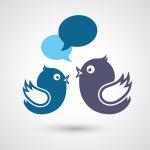Social media probably has a funny way of transforming from a novelty to a business necessity seemingly overnight for a lot of small and medium-sized business owners.
First, it might just be kids that appear to be using a service like Twitter to share what they’re having for lunch. Next it might be your customers talking about their challenges and what they’d like from their vendor partners. Without warning, competitors suddenly appear, offering comments and insights in response, with a follower count that seems larger than your entire email database.
That said, Twitter represents more than just another channel for businesses to connect with their audience. It’s a two-way source of communications that requires some knowledge of what’s appropriate, some time to build a following and some effort to manage — all of which may be outside of what seems reasonable based on the value it brings.
Instead of making a knee-jerk reaction and creating a Twitter account right away, it probably makes sense for SMB owners to evaluate their social media strategy a little more closely and rate the pros and cons first. The problem is, it’s difficult to know what those pros and cons are if you haven’t already been using a service like Twitter for a considerable amount of time.
To help address that knowledge gap, this post will look at some of the key questions you need to answer if you want to know whether Twitter is a must for your business, or merely a social media nice-to-have.
1. What Kind of Information do Your Customers Need, and Where do They Look for it?
If you’re running a business-to-consumer (B2C) company, you may find that customers and prospects prefer to learn about the kinds of products and services you offer through ads, your website and even direct mail. You might also find they turn to other social media platforms, like Facebook, as their primary channel to ask questions and exchange links to content related to your industry.
Business-to-business (B2B) firms, on the other hand, may have focused almost exclusively on driving demand and awareness through their own site using blog posts, white papers and infographics. They might have shared these through LinkedIn given the professional nature of that platform, while Twitter represents more of a constant stream of shorter, “real-time” updates. It’s not always clear if customers are doing their research on Twitter too.
To test this out, you might simply use the search engine on Twitter to browse keywords related to your industry or the products and services you sell. Put a hashtag (#) symbol in front of the keywords to find posts on Twitter (or tweets) that were specifically tagged with those terms. It will only take a few seconds to find out whether or not customers are actively discussing topics you care about on the platform, and what they’re saying.
Next, try searching for the names of a few customers with whom you’re on a first-name basis. Are they using Twitter for research? How many followers do they have (which can give you a sense of the influence they have with their peers)? Which of your rivals or other influencers already have accounts, and what are they saying that could get more attention from your firm, or put you at a competitive disadvantage?
2. How Likely are Customers to Use Twitter for Service-Related Issues?
Go to a specific account for one of the customers you found on Twitter. Scroll through their “feed,” or the series of recent tweets they’ve posted. There’s probably a mix of interesting articles or videos they’ve shared, some commentary on their daily life . . . and maybe a question or complaint aimed at a specific company with which they do business.
Pay close attention to these tweets, and click on them to see if the company in question responded, and how. This might look a lot different from the kind of customer service interaction you’re used to if you’ve primarily relied on a call centre. Twitter, however, shows how more customers are unwilling to wait to be heard and aren’t afraid of making their issue public at the moment it happens.
If it’s easy to imagine a similar scenario playing out with a customer who has purchased from your firm. For example, imagine how it might look if someone made a complaint or comment that essentially shared a negative experience and you had no way to respond.
3. How Can You Best Automate and Connect Twitter to Your Business Processes?
If you couldn’t find anything that indicated significant activity on Twitter based on the first two questions, you may only need to have a limited presence on Twitter, or even none at all. Most likely, however, there will be at least a portion of your audience on the service — and in the Age of the Customer, it’s critical to respect the channels in which they choose to engage.
That doesn’t mean you should turn using Twitter into a full-time job. There are a myriad of ways to connect Twitter to tools like Marketing Cloud and Service Cloud that make social media management less of a chore and more an extension of everyday work. It’s possible to schedule tweets in advance, for instance, or get notified immediately when service issues come in through the service.
In fact, as you become more familiar and sophisticated with a service like Twitter, it can represent an additional treasure trove of data you can use to better understand your customers and improve your ability to market to, sell to and service them. It’s also a way to humanize your company’s image by offering a conversational approach to interacting with them outside of face-to-face encounters. These are all things that should go into your return-on-investment (ROI) calculations to determine the value of using Twitter. That investment can be attributed to what you’re spending on marketing automation or just in the time you decide you need to spend on it.
Social media fads come and go, but Twitter is likely to be home to considerable activity for the foreseeable future — which may mean it makes sense for your business to find some kind of home on it.


























